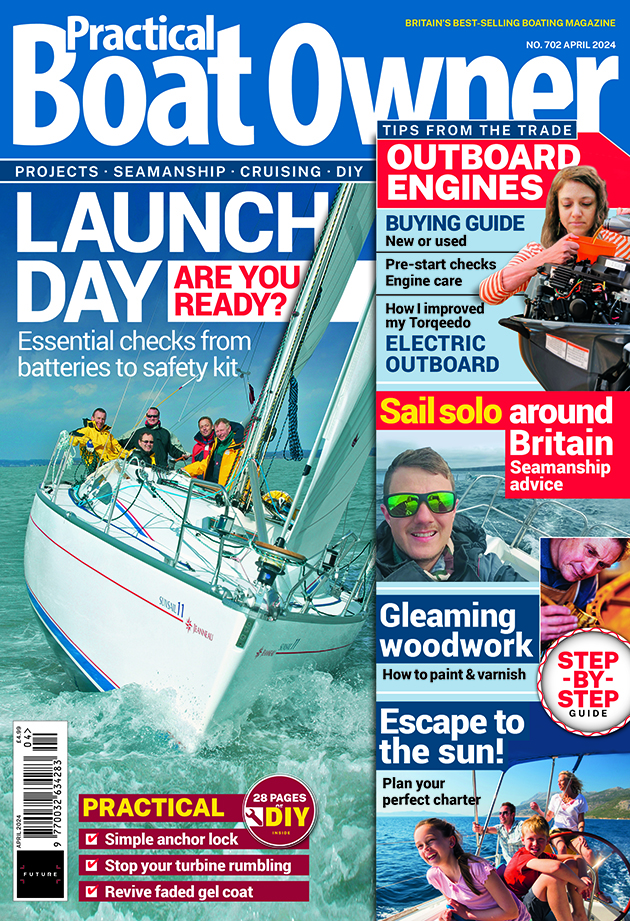Remy Laine shows how he made a low friction ring with integrated soft shackle
Creating your very own low friction ring with soft shackle might sound complex, but fear not – it’s surprisingly easy, writes Remy Laine.
Low friction rings represent a modern advancement of the wooden deadeyes that have been used for centuries on traditionally rigged ships.
With some basic splicing tools and a bit of Dyneema, we’ll guide you through the process of transforming a simple aluminium ring into a highly effective, lightweight, and budget-friendly block or fairlead.
For this project, I used a 14×10 ring from SavvySailor and 4mm D12 Dyneema from Marlow Ropes.
The tools required are a sharp knife, tape measure, fid/splicing needle, a winch, whipping twine, and a sail needle.
Start by determining the size of the shackle you’d like.
I opted for a small size to snugly fit around a stanchion, but you can make it as large as you prefer.

The finished low friction ring with integrated soft shackle. Credit: Remy Laine
Cut your Dyneema to the desired length (for reference I used 1m) and fold at the centre.
Using your fid or splicing needle, feed one end of the line into the core from the centre point and exit the line at your chosen distance (I used 80mm) to create the eye of the shackle.
Next, feed the line around the ring, as shown, interlocking the loose ends to secure the ring.
To create the locking splice, use your fid or splicing needle to feed one loose end through the other, just past the ring.
Repeat this process with the other loose end. To create the button which the eye will attach to we use a diamond knot.
Make two loops in the loose ends, as demonstrated.
Overlap the loops and feed the bottom end through the gaps, interlocking them as so: over, under, over, under, and under.
Then take the loose ends and feed them through the centre of the knot, tightening it.
To achieve a tightly cinched knot, use a fid or marlin spike and carefully work on it bit by bit.
Continues below…
How we designed and built a folding dinghy for under £350
A dinghy adds an enormous amount of fun to a cruising holiday, but on a small boat there is always…
DIY chartplotter for £200: how to build one at home
John Calton builds his own 10in touchscreen DIY chartplotter with GPS and AIS for a fraction of the cost of…
DIY at home: 100+ things to do and make in the workshop at home
In normal times we cover a lot of ground every month in Practical Boat Owner – online and in the…
To make the temporary pulling loop, take the two loose ends and use the fid or a splicing needle to feed them into one another at the halfway point, locking them with a few stitches of whipping twine – as it’s only temporary it needn’t look good.
Now comes the fun part!
Tie off the eye end of the shackle to a suitable hard point and the loop we just made to the end of a line led to a winch.
Use the winch to really tighten and harden up the diamond knot, which will compress.
You can then cut off the pulling loop close to the knot.
To finish you can add a bit of whipping twine to the inside of the eye to make opening and closing easier.
A dab of glue on the top of the diamond knot will also help smooth up the frayed ends.
Congratulations! You’ve now crafted an ultra-strong and highly portable block that can be used all over the boat.
I made six of these for our genoa furling line guides on the stanchions. The breaking load will be approximately 75% of the Dyneema used.
How to make a low friction ring with soft shackle: step by step

Credit: Remy Laine
1. The tools you’ll need to make the low friction ring.

Credit: Remy Laine
2. Cut your required length of Dyneema and fold in half.

Credit: Remy Laine
3. The end of the Dyneema is then fed into the core…

Credit: Remy Laine
4… interlocking the loose ends – over, under, over, under etc.

Credit: Remy Laine
5. Next make two loops in the loose ends to start your diamond knot.

Credit: Remy Laine
6. Then overlap the loops as shown here.

Credit: Remy Laine
7. Feed the loose ends through the centre to form the diamond knot.

Credit: Remy Laine
8. Work the rope until the diamond knot is tight.

Credit: Remy Laine
9. The finished diamond knot.

Credit: Remy Laine
10. Now tie a temporary pulling loop.

Credit: Remy Laine
11. Use a winch to crank the rope and tighten the diamond knot.

Credit: Remy Laine
12. Finally you can cut off the temporary loop with a knife.
Enjoyed reading How to make a low friction ring with soft shackle? 
A subscription to Practical Boat Owner magazine costs around 40% less than the cover price.
Print and digital editions are available through Magazines Direct – where you can also find the latest deals.
PBO is packed with information to help you get the most from boat ownership – whether sail or power.
-
-
-
- Take your DIY skills to the next level with trusted advice on boat maintenance and repairs
- Impartial in-depth gear reviews
- Practical cruising tips for making the most of your time afloat
-
-






